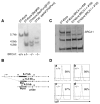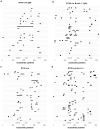Brca1 in immunoglobulin gene conversion and somatic hypermutation
- PMID: 18036997
- PMCID: PMC2267027
- DOI: 10.1016/j.dnarep.2007.10.002
Brca1 in immunoglobulin gene conversion and somatic hypermutation
Abstract
Defects in Brca1 confer susceptibility to breast cancer and genomic instability indicative of aberrant repair of DNA breaks. Brca1 was previously implicated in the homologous recombination pathway via effects on the assembly of recombinase Rad51. Activation-induced cytidine deaminase (AID) deaminates C to U in B lymphocyte immunoglobulin (Ig) DNA to initiate programmed DNA breaks. Subsequent uracil-glycosylase mediated U removal, and perhaps further processing, leads to four known classes of mutation: Ig class switch recombination that results in a region-specific genomic deletion, Ig somatic hypermutation that introduces point mutations in Ig V-regions, Ig gene conversion in vertebrates that possess Ig pseudo-V genes, and translocations common to B cell lymphomas. We tested the involvement of Brca1 in AID-dependent Ig diversification in chicken DT40 cells. The DT40 cell line diversifies IgVlambda mainly by gene conversion, and less so by point mutation. Brca1-deficiency caused a shift in Vlambda diversification, significantly reducing the proportion of gene conversions relative to point mutations. Thus, Brca1 regulates AID-dependent DNA lesion repair. Interestingly, while Brca1 is required to recruit ubiquitinated FancD2 to DNA damage, the phenotype of Brca1-deficient DT40 differs from the one of FancD2-deficient DT40, in which both gene conversion and non-templated mutations are impaired.
Figures







Similar articles
-
The BRCT domain of PARP-1 is required for immunoglobulin gene conversion.PLoS Biol. 2010 Jul 20;8(7):e1000428. doi: 10.1371/journal.pbio.1000428. PLoS Biol. 2010. PMID: 20652015 Free PMC article.
-
Activation-induced cytidine deaminase-mediated hypermutation in the DT40 cell line.Philos Trans R Soc Lond B Biol Sci. 2009 Mar 12;364(1517):639-44. doi: 10.1098/rstb.2008.0202. Philos Trans R Soc Lond B Biol Sci. 2009. PMID: 19008193 Free PMC article. Review.
-
Genetic evidence for single-strand lesions initiating Nbs1-dependent homologous recombination in diversification of Ig v in chicken B lymphocytes.PLoS Genet. 2009 Jan;5(1):e1000356. doi: 10.1371/journal.pgen.1000356. Epub 2009 Jan 30. PLoS Genet. 2009. PMID: 19180185 Free PMC article.
-
MSH6- or PMS2-deficiency causes re-replication in DT40 B cells, but it has little effect on immunoglobulin gene conversion or on repair of AID-generated uracils.Nucleic Acids Res. 2013 Mar 1;41(5):3032-46. doi: 10.1093/nar/gks1470. Epub 2013 Jan 11. Nucleic Acids Res. 2013. PMID: 23314153 Free PMC article.
-
Immunoglobulin diversification in DT40: a model for vertebrate DNA damage tolerance.DNA Repair (Amst). 2004 Jul 2;3(7):693-702. doi: 10.1016/j.dnarep.2004.03.042. DNA Repair (Amst). 2004. PMID: 15177178 Review.
Cited by
-
DNA Damage Tolerance Mechanisms Revealed from the Analysis of Immunoglobulin V Gene Diversification in Avian DT40 Cells.Genes (Basel). 2018 Dec 7;9(12):614. doi: 10.3390/genes9120614. Genes (Basel). 2018. PMID: 30544644 Free PMC article. Review.
-
Common light chain chickens produce human antibodies of high affinity and broad epitope coverage for the engineering of bispecifics.MAbs. 2021 Jan-Dec;13(1):1862451. doi: 10.1080/19420862.2020.1862451. MAbs. 2021. PMID: 33491549 Free PMC article.
-
RAD51 paralogs promote homology-directed repair at diversifying immunoglobulin V regions.BMC Mol Biol. 2009 Oct 28;10:98. doi: 10.1186/1471-2199-10-98. BMC Mol Biol. 2009. PMID: 19863810 Free PMC article.
-
The B cell mutator AID promotes B lymphoid blast crisis and drug resistance in chronic myeloid leukemia.Cancer Cell. 2009 Sep 8;16(3):232-45. doi: 10.1016/j.ccr.2009.07.030. Cancer Cell. 2009. PMID: 19732723 Free PMC article.
-
SUMOylation of PCNA by PIAS1 and PIAS4 promotes template switch in the chicken and human B cell lines.Proc Natl Acad Sci U S A. 2018 Dec 11;115(50):12793-12798. doi: 10.1073/pnas.1716349115. Epub 2018 Nov 28. Proc Natl Acad Sci U S A. 2018. PMID: 30487218 Free PMC article.
References
-
- Reynaud CA, Anquez V, Dahan A, Weill JC. A single rearrangement event generates most of the chicken immunoglobulin light chain diversity. Cell. 1985;40:283–291. - PubMed
-
- Reynaud CA, Anquez V, Grimal H, Weill JC. A hyperconversion mechanism generates the chicken light chain preimmune repertoire. Cell. 1987;48:379–388. - PubMed
-
- Reynaud CA, Dahan A, Anquez V, Weill JC. Somatic hyperconversion diversifies the single Vh gene of the chicken with a high incidence in the D region. Cell. 1989;59:171–183. - PubMed
-
- Muramatsu M, Sankaranand VS, Anant S, Sugai M, Kinoshita K, Davidson NO, Honjo T. Specific expression of activation-induced cytidine deaminase (AID), a novel member of the RNA-editing deaminase family in germinal center B cells. J Biol Chem. 1999;274:18470–18476. - PubMed
-
- Withers DR, Davison TF, Young JR. Developmentally programmed expression of AID in chicken B cells. Dev Comp Immunol. 2005;29:651–662. - PubMed
Publication types
MeSH terms
Substances
Grants and funding
LinkOut - more resources
Full Text Sources
Other Literature Sources
Research Materials
Miscellaneous

